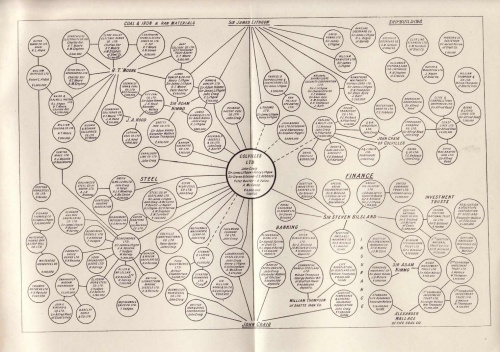Difference between revisions of "Power Structure Research"
(→Background) |
|||
| (3 intermediate revisions by the same user not shown) | |||
| Line 5: | Line 5: | ||
:There are two general aspects of any study that attempts to delineate a power structure and understand its workings. The first aspect is a "network analysis." A network analysis provides an empirical picture of (1) the interconnections among the key organizations and people in the power structure and (2) the operations of that network on policy issues. Such studies can reveal power structures to be more or less tightly knit, more or less focused in a few organizations or individuals, and more or less linked to a single social class. The second aspect of a power structure study is a "content analysis" of what is said and done within the power network. Such studies can provide information on the substance of new policies and an understanding of the strategies and values that underlie the policy planning of the power elite.’<ref>Domhoff, G. W. (2005) '[http://sociology.ucsc.edu/whorulesamerica/theory/power_structure_research.html Power Structure Research and the Hope for Democracy]' ''Who Rules America'', April.</ref> | :There are two general aspects of any study that attempts to delineate a power structure and understand its workings. The first aspect is a "network analysis." A network analysis provides an empirical picture of (1) the interconnections among the key organizations and people in the power structure and (2) the operations of that network on policy issues. Such studies can reveal power structures to be more or less tightly knit, more or less focused in a few organizations or individuals, and more or less linked to a single social class. The second aspect of a power structure study is a "content analysis" of what is said and done within the power network. Such studies can provide information on the substance of new policies and an understanding of the strategies and values that underlie the policy planning of the power elite.’<ref>Domhoff, G. W. (2005) '[http://sociology.ucsc.edu/whorulesamerica/theory/power_structure_research.html Power Structure Research and the Hope for Democracy]' ''Who Rules America'', April.</ref> | ||
| − | + | [[File:Real Rulers of Scotland 1940.jpg|thumb|right|500px|Network diagram from ''The Real Rulers of Scotland'' by Thomas Burns, published in Glasgow by the London Scots Self Government Committee, 1940]] | |
==Resources== | ==Resources== | ||
| + | *Val Burris [http://sociology.uoregon.edu/faculty/burris.php homepage and publications], University of Oregon. | ||
*http://en.wikipedia.org/wiki/The_Tipping_Point | *http://en.wikipedia.org/wiki/The_Tipping_Point | ||
*http://www.amazon.co.uk/Who-Runs-This-Place-Anatomy/dp/0719565642 | *http://www.amazon.co.uk/Who-Runs-This-Place-Anatomy/dp/0719565642 | ||
| Line 15: | Line 16: | ||
*Who Rules America http://sociology.ucsc.edu/whorulesamerica/ | *Who Rules America http://sociology.ucsc.edu/whorulesamerica/ | ||
*They Rule http://www.theyrule.net | *They Rule http://www.theyrule.net | ||
| − | *Exxon Secrets http://www.exxonsecrets.org | + | *Exxon Secrets http://www.exxonsecrets.org |
==See Also== | ==See Also== | ||
| Line 32: | Line 33: | ||
<references/> | <references/> | ||
[[Category:Research Methods]][[Category:Research]] | [[Category:Research Methods]][[Category:Research]] | ||
| + | [[Category:Power structure research]] | ||
Latest revision as of 15:24, 31 March 2014
Power structure research is a type of research which often uses Social Network Analysis http://www.uoregon.edu/~vburris/whorules/
Background
Pioneered by C Wright Mills and subsequent sociologists such as William Domhoff in the US and John Scott in the UK. According to Domhoff:
- There are two general aspects of any study that attempts to delineate a power structure and understand its workings. The first aspect is a "network analysis." A network analysis provides an empirical picture of (1) the interconnections among the key organizations and people in the power structure and (2) the operations of that network on policy issues. Such studies can reveal power structures to be more or less tightly knit, more or less focused in a few organizations or individuals, and more or less linked to a single social class. The second aspect of a power structure study is a "content analysis" of what is said and done within the power network. Such studies can provide information on the substance of new policies and an understanding of the strategies and values that underlie the policy planning of the power elite.’[1]
Resources
- Val Burris homepage and publications, University of Oregon.
- http://en.wikipedia.org/wiki/The_Tipping_Point
- http://www.amazon.co.uk/Who-Runs-This-Place-Anatomy/dp/0719565642
- http://www.amazon.co.uk/Who-Rules-Britain-John-Scott/dp/074560563X
- http://sociology.ucsc.edu/whorulesamerica/power/corporate_community.html
- http://www.businessweek.com/innovate/content/may2007/id20070504_739507.htm
- http://investing.businessweek.com/research/company/overview/overview.asp
- Who Rules America http://sociology.ucsc.edu/whorulesamerica/
- They Rule http://www.theyrule.net
- Exxon Secrets http://www.exxonsecrets.org
See Also
Investigative Research | Social Network Analysis
Further Reading
- Cohen, S. (1988) ‘The last seminar’ in Against Criminology, New Brunswick, NJ: Transaction books.
- Lee, R. (1993) Doing Research on sensitive topics, London: Sage.
- Peter Phillips, August 14, 2003 'Inside Bohemian Grove US Elites Celebrate Patriarchy, Racism and Class Privilege', CounterPunch http://www.counterpunch.org/phillips08142003.html
- Phillips, P, A Relative Advantage: Sociology of the San Francisco Bohemian Club A Doctoral Dissertation (1994) http://libweb.sonoma.edu/regional/faculty/phillips/bohemianindex.html
- Scott, J. (1990) A matter of record, Cambridge: Polity.
- Simpson, C ‘Scholars Perfect Psychological Warfare Techniques’ Excerpt from Science of Coercion: Communication Research and Psychological Warfare, 1945-1960 by Christopher Simpson (New York: Oxford University Press, 1996), pp. 48-51: http://www.cia-on-campus.org/social/simpson.html
- Walraff, G. (1978) Walraff: the Undesirable Journalist, London: Pluto.
- Williams, K. (1989). Researching the powerful: problems and possibilities of social research. Contemporary Crises, 13(3), 252-274.
Notes
- ↑ Domhoff, G. W. (2005) 'Power Structure Research and the Hope for Democracy' Who Rules America, April.
